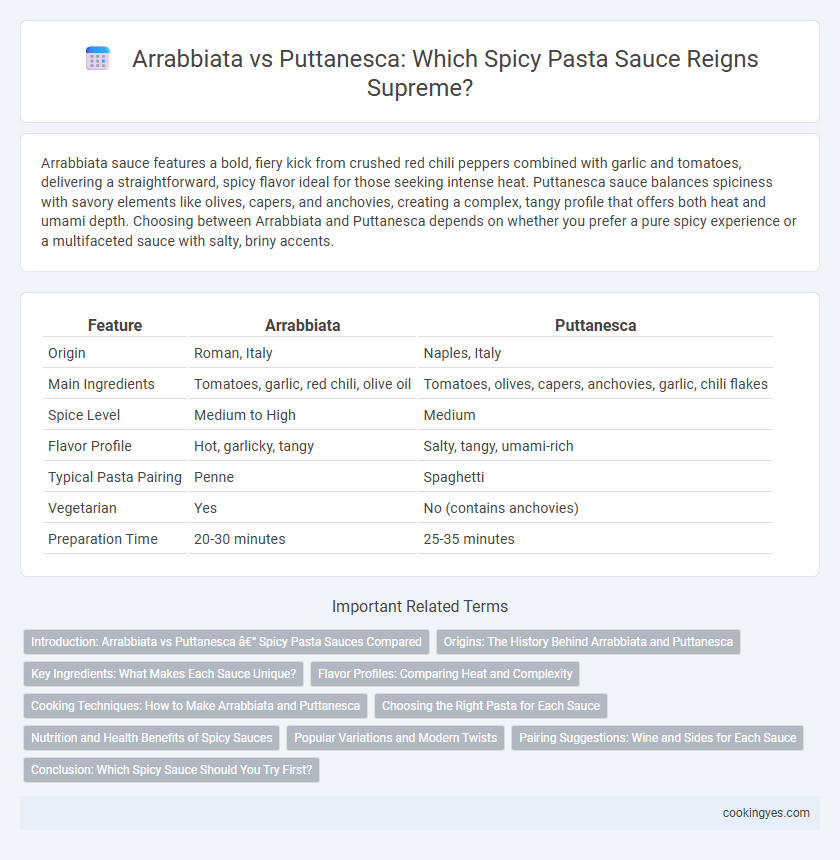Arrabbiata sauce features a bold, fiery kick from crushed red chili peppers combined with garlic and tomatoes, delivering a straightforward, spicy flavor ideal for those seeking intense heat. Puttanesca sauce balances spiciness with savory elements like olives, capers, and anchovies, creating a complex, tangy profile that offers both heat and umami depth. Choosing between Arrabbiata and Puttanesca depends on whether you prefer a pure spicy experience or a multifaceted sauce with salty, briny accents.
Table of Comparison
| Feature | Arrabbiata | Puttanesca |
|---|---|---|
| Origin | Roman, Italy | Naples, Italy |
| Main Ingredients | Tomatoes, garlic, red chili, olive oil | Tomatoes, olives, capers, anchovies, garlic, chili flakes |
| Spice Level | Medium to High | Medium |
| Flavor Profile | Hot, garlicky, tangy | Salty, tangy, umami-rich |
| Typical Pasta Pairing | Penne | Spaghetti |
| Vegetarian | Yes | No (contains anchovies) |
| Preparation Time | 20-30 minutes | 25-35 minutes |
Introduction: Arrabbiata vs Puttanesca – Spicy Pasta Sauces Compared
Arrabbiata sauce features a fiery blend of garlic, tomatoes, and red chili peppers, delivering a straightforward, intense heat that perfectly complements penne pasta. Puttanesca combines spicy elements with complex flavors from olives, capers, anchovies, and tomatoes, offering a savory and tangy profile alongside its warmth. Both sauces showcase Italian culinary tradition, but Arrabbiata emphasizes pure spice, while Puttanesca balances heat with briny and umami notes.
Origins: The History Behind Arrabbiata and Puttanesca
Arrabbiata sauce originated in the Lazio region of Italy, specifically Rome, characterized by its fiery blend of garlic, tomatoes, and red chili peppers. Puttanesca sauce traces back to Naples, known for its tangy and robust mix of olives, capers, anchovies, and tomatoes, reflecting a Mediterranean coastal influence. Both sauces embody distinct regional flavors that highlight Italy's culinary diversity and the cultural significance of spicy, savory pasta dishes.
Key Ingredients: What Makes Each Sauce Unique?
Arrabbiata sauce features key ingredients like garlic, red chili peppers, and tomatoes, which create its signature fiery heat and vibrant flavor. Puttanesca sauce stands out with its combination of olives, capers, anchovies, and tomatoes, offering a spicy, salty, and tangy taste profile. The presence of anchovies and briny elements in Puttanesca contrasts with the straightforward chili pepper heat in Arrabbiata, defining their unique spicy characteristics.
Flavor Profiles: Comparing Heat and Complexity
Arrabbiata sauce delivers a bold, fiery heat from red chili peppers combined with a simple yet intense garlic and tomato base, creating a straightforward spicy flavor. Puttanesca offers a more complex heat, balancing moderate spiciness with salty, briny notes from anchovies, olives, and capers, adding layers of savory depth. The choice between Arrabbiata's sharp heat and Puttanesca's multifaceted spiciness depends on preference for pure chili intensity versus intricate, umami-rich flavors.
Cooking Techniques: How to Make Arrabbiata and Puttanesca
Arrabbiata sauce is prepared by sauteing garlic and dried red chili flakes in olive oil, then simmering with crushed tomatoes to develop a vibrant, spicy flavor. Puttanesca sauce involves frying anchovies, garlic, capers, olives, and chili flakes in olive oil, creating a robust, umami-rich heat that complements the acidity of tomatoes. Both sauces require simmering to blend flavors, but Arrabbiata emphasizes a straightforward, fiery heat while Puttanesca balances spiciness with briny, savory notes.
Choosing the Right Pasta for Each Sauce
Arrabbiata sauce, known for its fiery blend of garlic, tomatoes, and red chili peppers, pairs best with penne pasta, as the ridges and tube shape effectively hold the spicy sauce. Puttanesca sauce, rich with robust flavors from olives, capers, anchovies, and tomatoes, complements longer, flat pastas like spaghetti or linguine to evenly distribute its bold, briny taste. Selecting the appropriate pasta shape enhances the fusion of sauce and noodles, intensifying the overall spicy flavor experience.
Nutrition and Health Benefits of Spicy Sauces
Arrabbiata sauce, made from tomatoes, garlic, and red chili peppers, offers a powerful dose of antioxidants and capsaicin, which can boost metabolism and reduce inflammation. Puttanesca sauce includes olives, capers, and anchovies, providing heart-healthy fats, essential minerals, and a rich source of omega-3 fatty acids, alongside a moderate level of spice. Both sauces enhance digestion and circulation, but Arrabbiata tends to deliver higher heat and metabolism-boosting compounds, while Puttanesca offers more balanced nutrition with added vitamins and minerals.
Popular Variations and Modern Twists
Arrabbiata sauce, traditionally made with garlic, tomatoes, and red chili peppers, has popular variations incorporating sundried tomatoes and smoked paprika for a deeper, smoky heat. Puttanesca sauce features a bold blend of olives, capers, anchovies, and chili flakes, with modern twists adding roasted red peppers or lemon zest to balance its spicy, salty profile. Both sauces inspire contemporary chefs to experiment with plant-based anchovy alternatives and infused chili oils, enhancing flavor complexity while catering to diverse dietary preferences.
Pairing Suggestions: Wine and Sides for Each Sauce
Arrabbiata, known for its fiery kick from red chili peppers and garlic, pairs excellently with a crisp Italian white wine like Verdicchio or a light-bodied red such as Chianti to balance the spice. Serve Arrabbiata with simple sides like garlic bread or a fresh green salad to complement its robust flavors without overpowering them. Puttanesca, featuring bold ingredients like olives, capers, and anchovies, matches well with a medium-bodied red wine like Barbera or a dry rose, enhancing the sauce's savory depth; sides like roasted vegetables or crusty bread provide a rich contrast to its complex umami profile.
Conclusion: Which Spicy Sauce Should You Try First?
Arrabbiata offers a bold, fiery kick with its simple blend of garlic, tomatoes, and red chili peppers, delivering a straightforward, spicy flavor perfect for those new to spicy pasta sauces. Puttanesca combines layers of heat with briny olives, capers, and anchovies, providing a more complex, piquant experience suited for adventurous palates. For a first spicy sauce, Arrabbiata is ideal due to its balanced heat and classic tomato base, making it an accessible introduction to spicy Italian cuisine.
Arrabbiata vs Puttanesca for spicy sauces Infographic

 cookingyes.com
cookingyes.com